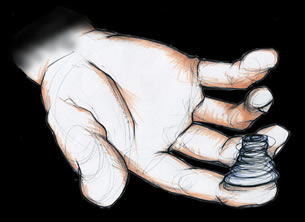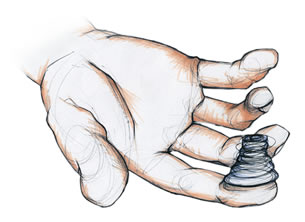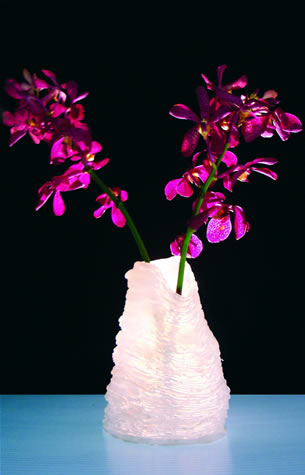Rapid Prototyped Embossed Fingerprint Vase
One-of-a-kind RP vase derives its form from the contours of a single fingerprint.
Latest News
February 28, 2008
By Susan Smith
 |
 |
In a world that values rapid prototyping (RP) for manufacturing of competitive consumer products such as automobile and aerospace parts and medical devices, Kris Lovett, a student at the University of Arts in Philadelphia, definitely has his finger on the pulse of something new and different for the use of rapid prototyping. Lovett designed his rapid prototyped embossed fingerprint vase/kit as an entry for the competition brief for the Collab Student Design Competition, held in conjunction with the Philadelphia Museum of Art. The competition brief is always linked thematically to that year’s Collab Design Excellence Award recipient.
This award, judged by industry leaders from around the world, offers a unique opportunity for students to experience tough competition and interact with colleagues from other universities and institutions.
Lovett’s design took its inspiration from the competition brief, “Variance and The Vase,” which reflected the unique design approach of the Collab Design Excellence Award recipient Gaetano Pesce. Pesce combined elements of art, design, philosophy, and technology in his work and encouraged the wondrous and accidental, embracing imperfections as traits that enhance and humanize his work. When his philosophy is applied to design for production it is referred to as “variance,” so basically no two vases could be alike.
Lovett adapted this concept to his own design, and took a real human fingerprint for the “variance” in his design, used Stratasys FDM (Eden Prairie, MN) printing to reads the fingerprints and convert them into a 3D object.
 “The form derives from the contours of a single fingerprint topographically printed. So the outer rings on an individuals fingerprint would make up the base while the tighter rings would make up the upper stem of the vase. (If you look at your finger from a profile view you will see that the larger rings are lower on the finger while the tighter rings are towards the top.) Basically these lines, or strokes rather, that make up these rings are scaled up in size from the original then pulled apart topographically to create the form,” Lovett said.
“The form derives from the contours of a single fingerprint topographically printed. So the outer rings on an individuals fingerprint would make up the base while the tighter rings would make up the upper stem of the vase. (If you look at your finger from a profile view you will see that the larger rings are lower on the finger while the tighter rings are towards the top.) Basically these lines, or strokes rather, that make up these rings are scaled up in size from the original then pulled apart topographically to create the form,” Lovett said.
Lovett’s process is as follows: “I take a fingerprint and scan it in. Then I open JPEG in Adobe Illustrator and use the live trace option, then expand the lines to give me the option to change the stroke and bump it up accordingly. From there the file is exported as a DXF so I can bring it into CSI Concepts Unlimited (Punch! Software, Kansas City, MO), a CAD application I use that supports integrated modeling, 2D drafting, photorealistic rendering, animation, advanced surfacing and associative 2D drawing generation. Then, in Concepts Unlimited, I extrude the strokes, giving the fingerprint dimension, then duplicate this form twice.”
One of the two extruded fingerprint forms is used to create a base with a flat surface attached. The second extruded fingerprint form is stacked in a pyramid fashion from ridge to ridge on top of the base creating the walls of the vase. Then the file is exported as an STL, and sent off to the Stratasys FDM printer so it can be printed from ABS.
The end result is a one-of-a-kind vase, based upon one individual’s unique fingerprint. For more information or to order a fingerprint vase, go to krislovett.com/embossed.html
For more information on the Collab Student Design Competition, please contact Collab by phone at (215) 763-8100 or by e-mail at [email protected].
Subscribe to our FREE magazine, FREE email newsletters or both!
Latest News
About the Author
DE’s editors contribute news and new product announcements to Digital Engineering.
Press releases may be sent to them via [email protected].






